Microbe Hunters, by Paul de Kruif
Author: M. Crasnier-Mednansky, Ph.D., D.Sc.Copyright © 2005 Mednansky Institute, Inc.
Here comes a tribute to bacteriologist Paul de Kruif (1890-1971), author of the acclaimed book Microbe Hunters published in 1926. The very thought of reading Microbe Hunters should not be discouraged, as it has been recently, solely because of Paul de Kruif's usage of archaic terminology.
Many microbiologists have read Microbe Hunters and those who have not, should. It particularly focuses on the heroic battles against infection and describes the struggle and quest of those who dared fighting infectious diseases. As the lively stories for van Leeuwenhoek (1632-1723), Spallanzani (1729-1799), Pasteur (1822-1895), Koch (1843-1910), Roux (1853-1933), Behring (1854-1917), Metchnikoff (1845-1916), Theobald Smith (1859-1934), Bruce (1855-1931), Ross (1857-1932), Grassi (1854-1925), Walter Reed (1851-1902) and Paul Ehrlich (1854-1915) unfold, the reader is overwhelmed.
Early observations by Antony van Leeuwenhoek, the Dutch draper from Delft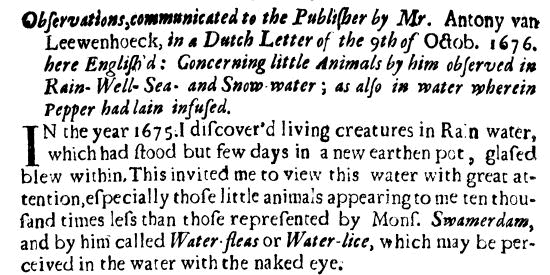
The October 9, 1676 letter by Antony van Leeuwenhoek was translated from Dutch by Henry Oldenburg (1615?-1677), First Secretary of the Royal Society (1663-1677). The letter is published in Philosophical Transactions of the Royal Society of London, 1677, Vol. 12, pp. 821-831
Paul de Kruif not only tracks the scientific facts but the hunters’ character in a bold and straightforward way, with passion. He praises van Leeuwenhoek for his honesty: "He had a sound instinct about the infinite complicatedness of everything -that told him the danger of trying to pick out one cause from the tangled maze of causes which control life". One can feel his admiration for Spallanzani who had "the strange self-forgetting spirit of a few rare men, those curious men to whom truth is more dear than their own cherished whims and wishes". He is astonished by Pasteur: "But one of Pasteur’s most charming traits was his characteristic of a scientific Phoenix, who rose triumphantly from the ashes of his own mistakes". He marvels at Koch’s modesty: "…never…did he seem to realize that he was the leader in the most beautiful and one of the most thrilling battles of men against cruel nature". He overlooks the massacre of the guinea pigs by Roux and Behring because "…they were saviors - and that is noble! - but this drove them sometimes into strange byways far off the road were you find truth…".
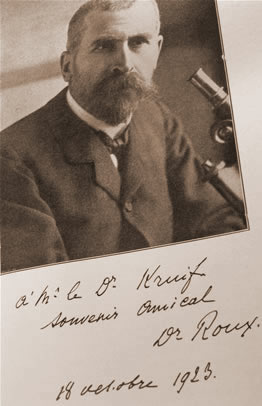
Dr. Roux, an illustration from the 1926 edition of Microbe Hunters. Emile Roux dedicated this photograph to Paul de Kruif with a friendly note on October 18, 1923
He is resentful towards Metchnikoff: "But the pitiful waste of this brainy Metchnikoff’s life was that he was always doing experiments to defend an idea, and not to find the hidden truths of nature".
Elie Metchnikoff: Founder of the phagocytic theory of immunity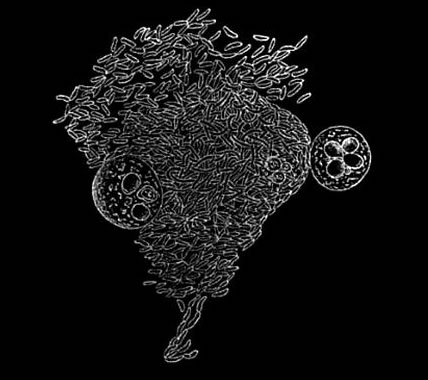
Figure is from L'immunité dans les maladies infectieusesGoogleBook (Immunity in infectious diseases) by Elie Metchnikoff, 1901. Figure represents microphage bursting due to growth of Vibrio metchnikovi in exudate from vaccinated guinea-pig.
He recognizes the pioneer in Theobald Smith: "It was this now nearly forgotten microbe hunting of Theobald Smith that first gave men the right to have visions of a world transformed". A pioneer with morality as he stated: "Science is privileged to exist only in so far as it contributes to the advancement of the human race, material, intellectual, social", in Theobald Smith's presidential address to the Society of American Bacteriologists, 1903
Theobald Smith's great discovery: Texas fever is transmitted by the cattle tick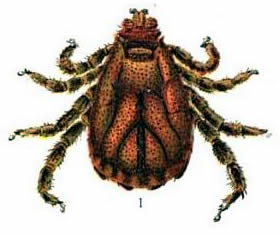
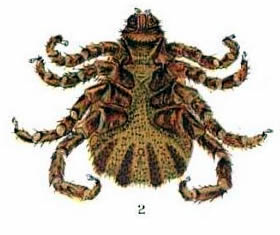
Dorsal (1) and ventral (2) views of male Texas fever tick (Margaropus annulatus) greatly enlarged, from Special report on diseases of cattleGoogleBook by Drs. Atkinson, Dickson, Harbaugh, Hickman, Law, Lowe, Mohler, Murray, Pearson, Ransom, Salmon, Smith, and Trumbower, 1912 revised edition
He shows respect for David Bruce: "There was something diabolical in the risks he took, and something yet more devilish in the way he could laugh -with a dry humor- and wish other microbe hunters might have died to prove some of his own theories. But he had a right to wish death for others". He is indignant at the Ross and Grassi scuffle: "To listen to these two, you would think each would rather this noble discovery had remained buried than have the other get a mite of credit for it".
Sir Ronald Ross and the malaria struggleThat forceful, vigorous personality, so full of eagerness, with a resolute, pugnacious mind and fierce yet kindly intelligence - Poet Laureate John Masefield at a memorial service, August 22, 1933
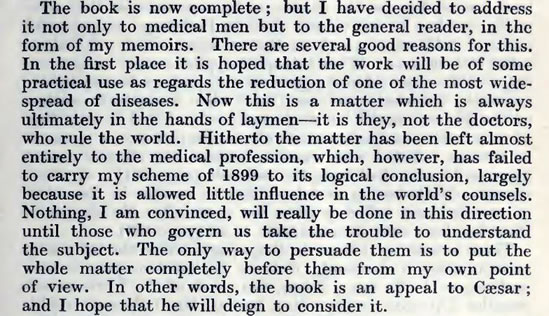
Excerpt is from MEMOIRS with a Full Account of the Great Malaria Problem and its Solution by Ronald Ross, 1923
Battista Grassi demonstrates only the Anopheles mosquito can transmit malaria to humans
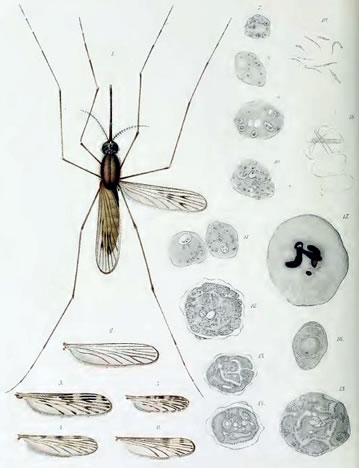
Figures is from Studi di uno zoologo sulla malaria by Battista Grassi, 1901
1: Anopheles claviger (female) 2-5: Wings of Anopheles 6: Wing of Culex mimeticus Noe 7-17: From Culex pipiens
He has mercy for Walter Reed however his apparent praise conveys disapprobation: "…never was there a good man who thought of more hellish and dastardly tests!"
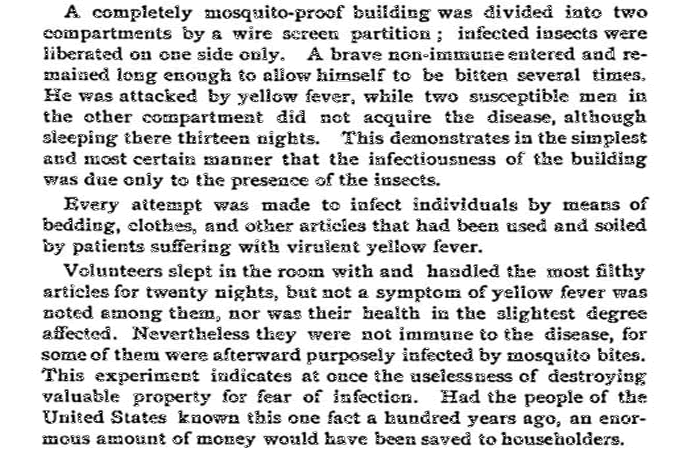
From Walter Reed: a memoirGoogleBook by Walter Drew McCaw, 1904. Excerpt: Money and full authority to proceed were promptly granted, and to the everlasting glory of the American soldier, volunteers from the army offered themselves for experiment in plenty, and with the utmost fearlessness.
He has sympathy for Paul Ehrlich: "…let us think of the good brave adventurer Paul Ehrlich was and the thousands he has saved".
Triumph in chemotherapy: Ehrlich and Hata's discovery in 1910 of the arsenical drug '606' or Salvarson.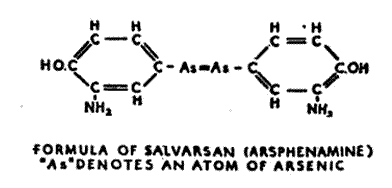
Salvarson (that which saves by arsenic) had the most astonishing effect on syphilis which resulted in much more research on chemotherapeutic remedies. Formula is from The Conquest of Bacteria: From Salvarsan to Sulphapyridine by F. Sherwood Taylor, 1942.
The reading of Microbe Hunters has triggered, among scientists of notoriety, both passion and dedication toward microbiology, and students and young researchers have found in it a never-ending source of inspiration. Let's now revive Paul de Kruif's own confession "…I love these microbe hunters…Not especially for the discovery they have made nor for the boons they have brought mankind. I love them for the men they are. I say they are, for in my memory every man jack of them lives and will survive until this brain must stop remembering". To read Paul de Kruif’s Microbe Hunters is to be steered towards remembrance of these men in an emotional and definitive way. And one must acknowledge the veracity in Paul de Kruif’s description of these pioneers’ human nature and their contribution to mankind.
Suggested Reading:Microbe Hunters revisited by W. C. Summers, International Microbiology, March 1998, Volume 1, Number 1
At Nobelprize.org, Nobel Lectures by 1901 Laureate Emil von Behring, 1902 Laureate Ronald Ross, 1905 Laureate Robert Koch and 1908 Laureates Paul Ehrlich and Ilya Mechnikov
At Biographical Memoirs of Fellows of The Royal Society, Obituary Notices for David Bruce and Ronald Ross (payment requested)
Lazzaro Spallanzani (1729-1799) by G. E. Burget was read before the 'University of Oregon Medical History Club' on October 12, 1923 (Lazzaro Spallanzani, by G.E. Burget at the University of Oregon Libraries)
Investigations into the etiology of traumatic infective diseasesGoogleBook by Robert Koch, translated by W. Watson Cheyne, 1880
The suppression of tuberculosisGoogleBook by Emil von Behring, translated by Charles Bolduan
Life of Elie Metchnikoff by Olga Metchnikoff, 1921
A great American scientistGoogleBook by James Middleton in 'The World's Work' (Editor Arthur W. Page), Volume 28, 1914
Excerpt: These observations, says Dr. [Theobald] Smith in his published report, forced upon me like a flash the conviction that we were here in the presence of a wholly new fact in the cause of disease. This was the introduction of the disease by inoculation. … The body of an insect … makes an unexceptionable culture tube. And its bill or beak makes an ideal hypodermic syringe.
MEMOIRS with a Full Account of the Great Malaria Problem and its Solution by Ronald Ross, 1923
Suggested Movies:
The Fight for Life (1940) written and directed by Pare Lorentz, based on The Fight for Life by Paul de Kruif (1938)
Life History of a Mosquito (1928) made by Kodak Research Laboratories in collaboration with the Department of Bacteriology of the Medical School, University of Rochester (filmed mosquito Aedes aegypti is carrier of the yellow fever virus)
Captured frame from Dr. Ehrlich's Magic Bullet (1940) from Director William Dieterle, Edward G. Robinson as Dr. Paul Ehrlich and O. Kruger as Dr. Behring
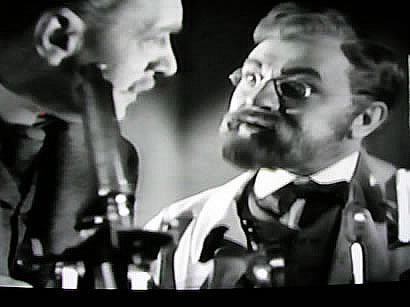
Emil von Behring: What do you mean affinity?
Paul Ehrlich: The attraction certain atoms possess for certain other atoms causes them to unite and form compounds.
Emil von Behring: Most extraordinary!
…
Paul Ehrlich: Of course it all depends of discovering the special dye which has an affinity for the substance one wishes to stain.
Emil von Behring: Specific staining! Great heavens, what about a microbe? Do you think it will be possible to stain a microbe and nothing else on the slide?
Paul Ehrlich: It would be possible, I think.
Note: Ehrlich introduced methylene blue, one of the most extensively used dye in bacteriological work. It was used by Koch to reveal the tubercle bacillus (Mycobacterium tuberculosis).
In 1940, a complete and unabridged version of Microbe Hunters was published under the title Dr. Ehrlich's Magic Bullet to bring focus on the Warner Brothers motion picture Dr. Ehrlich's Magic Bullet
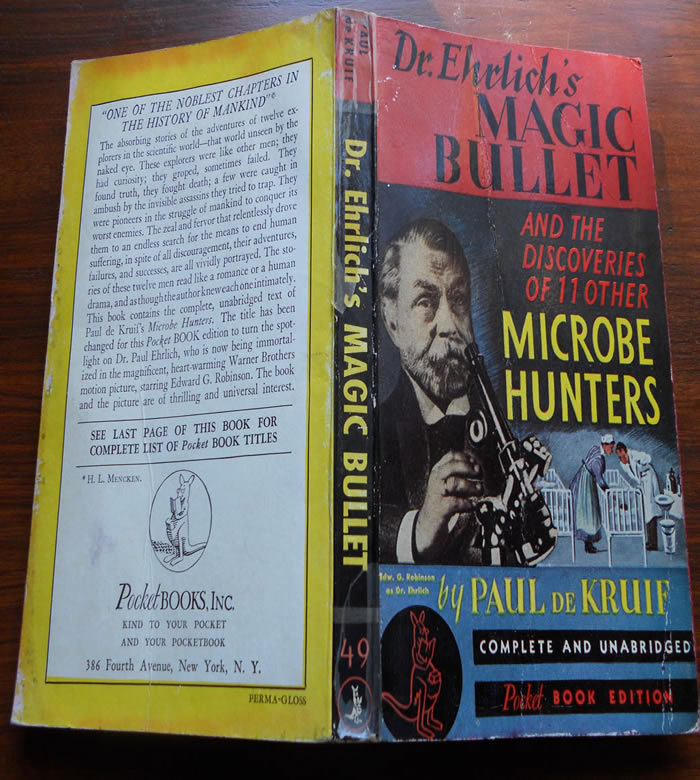
Minst.org Online Library Index